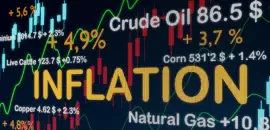The Fed Slowed its Pace of Interest Rate Hikes in December
More recently, Consumer Price Index (CPI) inflation eased to 7.1% in November from a peak of 9.1% in June, and is expected to decelerate further in the coming year. The Fed responded by slowing the pace of rate hikes to 50 basis points at its December 2022 FOMC meeting to 4.2% to 4.5%, and it signaled that the funds rate could peak at 5% to 5.25% early next year. Fed Chairman Jerome Powell emphasized that the Fed retained its commitment to its 2% inflation target, and rates are likely to stay elevated until it is confident that inflation is under control.
The Fed’s median forecasts for 2023 call for real GDP growth of 0.5%, while the unemployment rate is expected to reach 4.6%. Its preferred measure of inflation – the personal consumption deflator – is forecast to slow to 3.1% by year’s end, down from 5.6% currently.
Economists Split on Raising the Target Interest Rate in 2023
Harvard economist Jason Furman, however, warns that the economy could be headed for an “incomplete hard landing.” He envisions inflation coming down to about 3.5% under current policy, which would leave it well above the stated goal of 2%. If so, the Fed would either need to do another round of tightening to meet its target or raise it. In Furman’s view, the latter may be preferable if job losses are high and persist for a long time.
Former New York Fed President Bill Dudley disagrees. He believes the Fed already has raised its inflation objective implicitly, as there is no mention of it aiming for a rate below 2% to offset recent large overshoots. Another consideration is that a higher target could increase economic friction and uncertainty as households and businesses determine where inflation is headed.
The key issue for many economists is that raising the target rate could undermine the Fed’s credibility. As Dudley states: “Moving the goal posts would be interpreted as a failure, making it more difficult to anchor expectations around the new objective.
How Will Investors Respond to Elevated Inflation?
This begs an important question: will investors care if the Fed tolerates inflation of 3% to 4% if the economy slips into recession?
One of the most unusual aspects of the current environment is how wrong bondholders have been about inflation. They initially concurred with the Fed’s view that the spike was linked to supply-chain disruptions, and they thought it would be temporary. Then, when the Fed became more aggressive about lowering inflation, investors’ expectations about where rates were headed lagged what policymakers were signaling.
The bond market, for example, currently is pricing in a funds rate that is lower than the Fed’s projections. Moreover, bondholders believe the Fed will respond to economic weakness by lowering rates in the second half of 2023.
For their part, equity investors appear more concerned about the impact Fed tightening will have on the economy and corporate profits than on whether inflation will increase uncertainty. Thus, the stock market has rallied on economic weakness, because it increases the likelihood that the Fed will pivot from tightening policy further. Conversely, the market has sold off when data are strong.
Can One Infer That the Fed Has a Free Pass to Ease Policy if Inflation Proves Sticky?
My take is that investors ultimately will assess both the near-term and longer-term consequences of monetary policy. The main reason they appear unconcerned about the spike in inflation is that it has come after three decades in which it was under control.
During that span, the Fed established its credibility as an inflation fighter, and there is no evidence to suggest it is in jeopardy now. This is apparent from the behavior of U.S. financial markets and the strength of the U.S. dollar.
A test of the Fed’s credibility, however, could occur if inflation were to stay elevated for a while longer and the Fed paid greater attention to unemployment. If so, investors could take away the “free pass” the Fed currently enjoys.
In a Wall Street Journal commentary, Mickey Levy and Charles Plosser contend that the Fed needs to reformulate the strategic plan that was adopted in 2020. It deviated from the fundamental theme of the Volcker-Greenspan era that price stability is the most important contribution monetary policy can make for sustained economic growth and job creation. Specifically, they call for the framework of average inflation targeting to be discarded in favor of a simple 2% target with numeric tolerance bands. They see this as the clearest way to convey the Fed’s commitment to keep inflation low.
In the end, a key reason for the Fed to maintain its 2% inflation target is that it was integral to the “Global Moderation” — the period of economic prosperity and relative macro stability that lasted for three decades. During this period, central banks successfully targeted low inflation, which increased the confidence of households and businesses and enabled interest rates to stay low.
By comparison, the past three years suggest we may be entering a period of “Great Volatility” as the global economy has been buffeted by the COVID-19 pandemic, Russia’s invasion of Ukraine and the effects of climate change. While these forces will likely lead to weakness ahead, the decisions that the Fed and other central banks take to deal with high inflation can mitigate and limit the ultimate impact of these shocks. This is the main reason the Fed should persevere in keeping inflation low.
A version of this article was posted to TheHill.com on December 15, 2022.
This publication has been distributed for informational purposes only and should not be considered as investment advice or a recommendation of any particular security, strategy, or investment product. Opinions expressed in this commentary reflect subjective judgments of the author based on the current market conditions at the time of writing and are subject to change without notice. Information and statistics contained herein have been obtained from sources believed to reliable but are not guaranteed to be accurate or complete. Past performance is not indicative of future results. No part of this publication may be reproduced in any form, or referred to in any other publication, without express written permission of Fort Washington Investment Advisors, Inc.



























